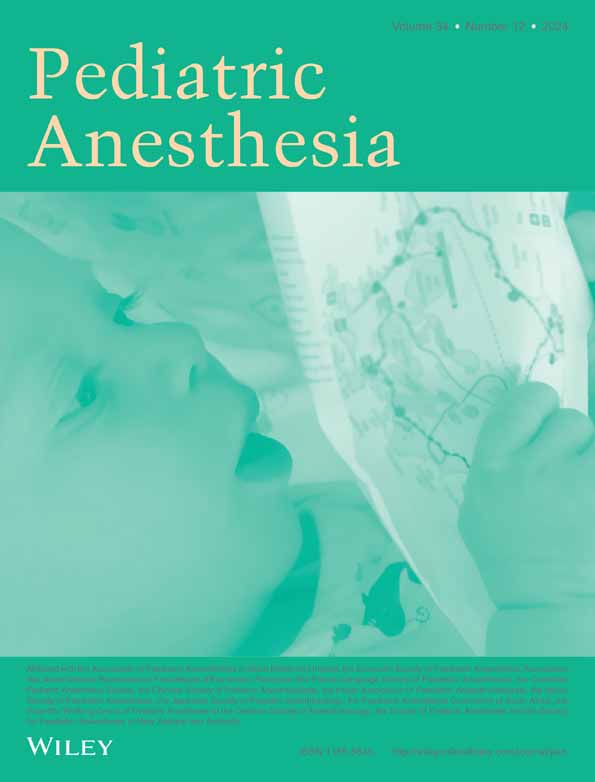Auricular laser acupuncture as an adjunct for parental anxiety management during children's surgery: A randomized-controlled study
Section Editor: Nada Sabourdin
Abstract
Background
Pediatric surgery is associated with high levels of anxiety for both children and parents/caregivers. To mitigate anxiety, auricular acupuncture has shown its potential in the perioperative setting. Accordingly, our team developed a wearable prototype auricular laser acupuncture system, AcuHealth V1.0, as a portable acupuncture device and conducted a proof-of-concept evaluation with parents of children undergoing surgery.
Aims
The primary aim of this study was to conduct feasibility testing of the AcuHealth V1.0 system in delivering auricular laser acupuncture.
Methods
Parents of children who were scheduled to undergo outpatient surgery were randomly assigned to one of three groups: authentic acupuncture (laser beams at known anxiolytic acupoints, n = 13), sham acupuncture (non-anxiolytic acupoints, n = 14), or a placebo control group (inactive laser, n = 14). Parent self-reported anxiety (0–10 numerical rating scale) was assessed at baseline, pre-intervention (once child was taken to the OR), post-intervention, and at 30 min after the intervention. Usability and acceptability data regarding the device were assessed after the intervention.
Results
Baseline data revealed no significant difference in anxiety between the three groups. Parent-reported anxiety level at 30-min post-intervention as compared to baseline in the authentic group was significantly decreased (delta mean ± std = −3.58 ± 2.07) compared to both the sham acupuncture (−1.35 ± 2.65) and placebo control group (0.54 ± 1.13). Evaluation of changes in parent-reported anxiety between groups over time using two-way repeated-measures analysis of variance (ANOVA) revealed a significant difference between the three groups (p = 0.001). Post hoc analysis with Scheffe test pairwise comparisons showed that at 30-min post-intervention compared to baseline, the authentic intervention group was significantly less anxious compared with both the sham group (p = 0.033) and the placebo control group (p = 0.001). Additionally, feedback regarding the usage of the device supported the acceptability and usability of the device with no adverse events.
Conclusions
This pilot study administering laser auricular acupuncture via the AcuHealth V1.0 system decreased parental anxiety after 30 min in parents who received treatment immediately after their children were taken to the operating room with no adverse effect.
1 INTRODUCTION
Millions of children undergo surgery in the United States each year,1 and many children experience significant perioperative anxiety that impacts clinical and behavioral outcomes.2 Importantly, parents and caregivers of children undergoing surgery also experience anxiety, which can exacerbate children's distress and affect surgical outcomes3-5 including anxiety, pain, and behavioral recovery. Surgical preparation programs targeting child and parent perioperative anxiety are limited, prompting the need for innovative solutions.
In response to this need, auricular acupuncture has emerged as a low-cost, promising, non-pharmacological option for the reduction of anxiety.6 Although findings vary across studies, there is growing evidence supporting auricular acupuncture as a viable alternative for anxiety mitigation.7, 8 Previous work from our group demonstrated that auricular acupuncture significantly decreased anxiety and pain in adults, including preoperative anxiety in adults as well as parents of children undergoing surgery.9-11 Traditional needle acupuncture, however, has practical and psychological barriers impeding the ability to implement this approach more broadly.
The development of laser acupuncture presents a novel, non-invasive approach to pain and anxiety management via acupuncture,12 which can facilitate implementation in populations who may be needle averse and is associated with less risk of infection compared to needle acupuncture.13-15 There are different types of laser devices available in the market or clinic setting for laser acupuncture therapy, including handheld “laserpen”16-18 and “laserneedle.”19-21 The former devices need practitioners to hold the device steadily to stimulate one pressure point each time and the latter device is not portable for clinical settings. The variation in laser parameters used, coupled with disparity in outcome interpretation for optimal therapy, has led to contradictory conclusions and inconsistent reports of clinical effectiveness.22 Moreover, the traditional application of acupuncture involves intensive training to locate acupuncture points. Accordingly, the development of a platform equipped with a real-time monitoring camera offers a significant opportunity to extend the practice of acupuncture beyond traditional clinical settings.
The AcuHealth V1.0 system, illustrated in Figure 1, is a wearable prototype designed by our team for easy, tele-controllable application of auricular laser acupuncture in both demanding clinical and everyday remote settings.22 It employs interchangeable laser beams which can be changed for different wavelengths and aimed at different auricular acupuncture points with the power output of each beam being individually adjustable by dedicated software. Embedded cameras in the AcuHealth V1.0 system facilitate remote laser acupuncture practice. This reduces the training requirement to locate the acupoints, which will facilitate the ability implementation of the device by clinicians in perioperative settings in the future (e.g., Anesthesiologists), rather than requiring involvement of practitioners trained in Traditional Chinese Medicine.
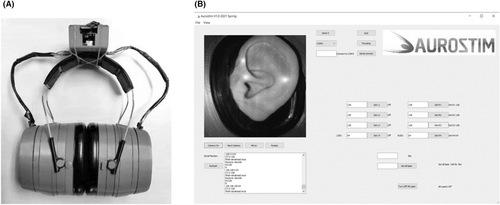
Our group has previously evaluated a protocol for the implementation of auricular acupuncture via needles in the perioperative setting for the management of surgical anxiety, demonstrating that targeting specific acupuncture points was effective in lowering preoperative anxiety as compared to sham acupuncture.6, 9 Following this same protocol, our study explored the utilization of the same auricular acupuncture approach using a laser acupuncture technique, which offers a non-invasive, pain-free approach with a broader range of applications and minimal risk of infection. Accordingly, the primary aim of this proof-of-concept randomized controlled trial (RCT) was to examine the efficacy of implementing the AcuHealth V1.0 laser acupuncture system to target parental anxiety during children's surgery. The secondary aim was to evaluate the device usability, comfort, and acceptability.
2 MATERIALS AND METHODS
2.1 Study design and interventions
Participants in this RCT were 41 parents of children who were scheduled to undergo outpatient elective surgery at Children's Hospital of Orange County (CHOC). Consistent with our previous work,6, 9 inclusion criteria were parents who could read and speak English, had no major medical or psychiatric illness, and had no prior experience with acupuncture. Parents whose children were undergoing emergency surgery or who could not read and/or speak English were excluded from this study.
Sample size was calculated a priori based on previous research.9 Given a three-group repeated-measures design, a 25% intervention effect, and a significance level of 0.05, a sample size of 36 (each group:12) was needed to yield a power of 0.85. The intervention effect size of 25% refers to an anticipated η2 = 0.25 effect between independent groups variable and the dependent NRS score for parent self-reported anxiety. Our team assessed the eligibility of 106 parents. Of those, 44 were excluded for not meeting inclusion criteria, and 19 declined to participate, primarily because their children's surgeries were short, and parents were concerned about being present when their children awoke from surgery (see Figure 2). Accordingly, we had a total of 43 parents randomized and who received the intervention. Two of the enrolled participants did not complete all the surveys assigned. All participants provided informed consent for this study, and the CHOC Institutional Review Board approved the study protocol.
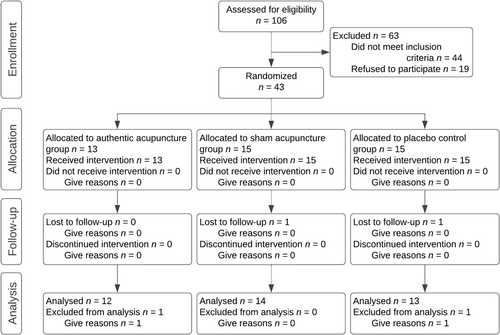
- Authentic acupuncture group. Participants in this group received bilateral auricular laser acupuncture at the Relaxation/Shenmen/Point Zero points.6, 11 A total of six laser beams with continuous wave (780 nm, 5 mW) were embedded to illuminate each of the six auricular acupoints for 5 min. The location of these acupoints is shown in Figure 3A,B.
- Sham acupuncture group. Participants in this group received bilateral auricular acupuncture at the shoulder, wrist, and extraneous auricular points defined as acupoints that are not documented to have any relaxation or anxiolytic effect.10 A total of six laser beams with continuous wave (780 nm, 5 mW) were embedded to illuminate each of the six auricular acupoints for 5 min. The location of these acupoints is shown in Figure 3C,D.
- Placebo control group. Participants in this group wore the headset but did not receive any auricular laser acupuncture. All laser beams were off during the study, as shown in Figure 3E,F.
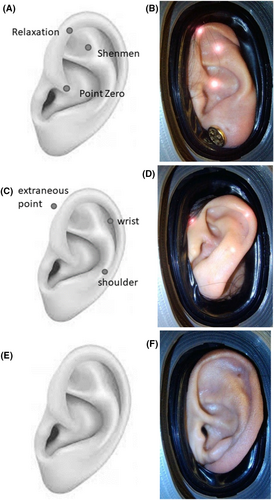
For this feasibility study, each continuous wave laser (semiconductor laser) was set to 5 mW, irradiating auricular points for 5 min at 780 nm, delivering 1.5 Joules per point, with 1 mm estimated beam diameter. Therefore there was 1.5 Joules energy irradiated per point. The power density was 6.4 mW/mm2 and the energy density was 1.9 J/mm2. Based on the power density, the lasers we used in this study was Low-Level-Laser (LLL) and classified as Clase 3R laser according to EN 60825–1.
All participants in this study were informed that they were randomly assigned to different groups and may or may not receive “real” laser acupuncture. Randomization group numbers were generated by the research assistant via an online randomization website prior to patient recruitment. The first author (W.L.) administered the operation of the device and conducted the intervention. Localization of auricular acupoints was under guidance from a Traditional Chinese Medicine trained and licensed acupuncturist (S.W.). To avoid the possibility of bias, communication with participants was standardized (e.g., a greeting, an introduction, and an explanation of the procedure).
2.2 Measures
2.2.1 Demographic questionnaire
Demographics were collected from participants, including gender, relation to the child, marital status, age, race/ethnicity, child age, child gender, child race/ethnicity, and household income. In addition, participants were also asked their perceptions of acupuncture effectiveness on reducing anxiety using a 6-point Likert-type scale (0–5), where 0 = do not know acupuncture, 1 = do not believe acupuncture will reduce anxiety at all and 5 = completely believe acupuncture will reduce anxiety.
2.2.2 State–trait anxiety inventory (STAI)
STAI is a widely used self-reported anxiety assessment instrument for adults.23 The questionnaire contains two separate, 20-item, 4-point self-reported rating scales for measuring trait and state anxiety. Total scores for situational and trait anxiety range from 0 to 80 each; higher scores denote higher levels of anxiety.23 For our purposes, participants completed both the state and trait forms as a baseline anxiety assessment.
2.2.3 0–10 Numeric rating scale for anxiety (NRS-anxiety) survey
The NRS was used to assess participant self-reported anxiety on a 0 to 10 scale, where 0 = no anxiety at all and 10 = the worst anxiety possible. This survey was repeatedly administered to participants four times during the study, that is, baseline (30 min pre-intervention), pre-intervention (once child was taken to the OR), post-intervention (immediately after the 5-min laser acupuncture intervention), and 30 min post-intervention (30 min after the laser acupuncture intervention). Prokopowicz et al.24 validated the Numerical Anxiety Rating Scale (NRS-A) for assessing anxiety in adults, demonstrating its accuracy and reliability when compared to the STAI. Accordingly, the STAI was implemented to ensure equivalence of anxiety across groups at baseline and the NRS was used to evaluate anxiety repeatedly throughout the study protocol for efficiency of anxiety assessment.
2.2.4 Usability and acceptability feedback questionnaire
The assessment of usability and acceptability was collected through a post-intervention questionnaire. Participants were asked to provide feedback on the AcuHealth V1.0 system and the intervention, including usability ratings and level of sensations experienced from the device. The survey included a question to ask participants to rate how effective they thought the device was for lowing their state anxiety using a five-point Likert-type scale (1–5), where 1 = do not believe this device will reduce anxiety at all and 5 = completely believe this device will reduce anxiety. This post-intervention belief question was reflective of the actual experience and outcomes perceived by the participants in order to assess feedback on perceptions and satisfaction with the device. To assess sensation experienced from the device, participants were asked to rate a variety of sensations using a five-point Likert-type scale (1–5), where 1 = no sensation at all and 5 = so much sensation it was unbearable (e.g., heat, numbness, soreness, heaviness, tingling, tugging, dizziness, headache, fatigue). Finally, participants were asked to rate the comfort of the device, where 1 = not comfortable at all and 5 = completely comfortable.
2.3 Study procedures
- Once consented, participants were asked to complete the demographic questionnaire, STAI, and NRS on a provided electronic tablet.
- After children were taken to the OR, parents were taken to a dedicated room for the study, where participants completed another NRS to assess anxiety.
- The research assistant then placed the AcuHealth V1.0 device on the participant's head. After the research assistant ensured the lasers aligned with the desired acupoints, a 5-min intervention was conducted according to the group assignment. During the intervention, lasers were turned off (placebo control group) or turned on (authentic acupuncture and sham acupuncture groups) and constantly stimulated corresponding acupoints. Once the 5-min intervention period ended, the research assistant removed the device.
- Upon completion of the intervention, the NRS was implemented again along with the usability and acceptability feedback questionnaire.
- The final assessment point occurred 30 min after the intervention ended, wherein participants were asked to self-report their state anxiety severity using the NRS via a survey sent through a short messaging service (SMS) text.
2.4 Analytic approaches
All variables were first tested for normality (skewness) using Shapiro–Wilk test. For any variables not normally distributed, we used Kruskal–Wallis one-way ANOVA to examine group differences in anxiety and provided η2 as effect size. If a variable was normally distributed, we then use one-way or two-way repeated-measures ANOVA. Post-hoc pairwise comparisons evaluated differences between each of the three groups to evaluate changes in anxiety from baseline to the 30-min post-intervention timepoint using the Scheffe test. Data regarding sensations experienced while using the device were coded as categorical variables (yes/no) for feeling or not feeling a sensation. Chi-square analysis was conducted for categorical variables and Spearman's rank-order correlations for evaluating the correlation between categorical and continuous data. All variables were evaluated for outliers and accordingly, we identified two significant outliers (one in the authentic group and one in the placebo group) where self-reported NRS-Anxiety variation (from baseline to 30-min post-intervention) was greater than three standard deviations from the mean and thus were excluded from subsequent analysis given the potential impact of this variability on statistical power and potential for lack of participant representativeness of these two participants. The 95% Confidence Intervals (CIs) for the error bars were calculated using SPSS, which employs an algorithm based on the t-distribution. Adjustment for multiple comparisons to control the overall error rate is Bonferroni method. The statistical software used is IBM SPSS Statistics Version 29 and the statistical significance threshold was set at p < .05.
3 RESULTS
3.1 Participants
Participant flow through the study is presented in Figure 2. No adverse events occurred during the study. Baseline characteristics including participant and child age, years of education, STAI, baseline NRS-Anxiety level are presented in Table 1. There were no significant differences among the groups on baseline data.
| Parents baseline characteristics | Authentic acupuncture group (n = 13) | Sham acupuncture group (n = 14) | Placebo control group (n = 14) | One-way ANOVA test p |
|---|---|---|---|---|
| Age, years | 37.62 ± 6.09 | 42.86 ± 7.51 | 40.50 ± 8.33 | .197 |
| Education, years | 15.23 ± 2.09 | 14.00 ± 2.60 | 15.71 ± 2.20 | .190 |
| Childresn's age | 6.62 ± 5.49 | 11.86 ± 7.58 | 9.43 ± 6.38 | .151 |
| Trait Anxiety (STAI) | 33.23 ± 8.47 | 34.71 ± 5.69 | 30.07 ± 7.49 | .239 |
| State Anxiety (STAI) | 40.08 ± 9.47 | 36.21 ± 10.11 | 38.79 ± 9.86 | .529 |
| Baseline NRS_anxiety, 0–5 scale | 5.38 ± 2.36 | 5.21 ± 2.12 | 4.43 ± 2.28 | .517 |
| Baseline heart rate, beats/min | 74.69 ± 8.33 | 72.93 ± 5.53 | 70.57 ± 10.96 | .462 |
| Baseline systolic blood pressure, mmHg | 121.85 ± 12.30 | 123.71 ± 14.06 | 117.86 ± 12.96 | .491 |
| Baseline diastolic blood pressure, mmHg | 89.69 ± 14.68 | 84.85 ± 9.23 | 81.00 ± 8.11 | .133 |
| Belief in laser acupuncture 0–5 scale, 0 = do not know acupuncture | 2.62 ± 1.33 | 3.07 ± 1.64 | 2.86 ± 1.46 | .630 |
- Note: p value presented in this table were analyzed using one-way ANOVA as detailed in the analytic approaches section.
3.2 Group differences in self-reported NRS-anxiety
To adjust for variability in baseline anxiety, we calculated the difference in anxiety from baseline to 30-min post-intervention for each participant in order to evaluate changes in anxiety as the primary outcome.
The mean and confidential interval of NRS-Anxiety over time was shown in Figure 4. As shown in Figure 5, Parental NRS-Anxiety at 30-min post-intervention as compared to baseline in the authentic acupuncture group was significantly decreased (delta mean ± std = −3.58 ± 2.07 – a 30% reduction) compared to both the sham acupuncture (−1.35 ± 2.65) and placebo control group (0.54 ± 1.13).
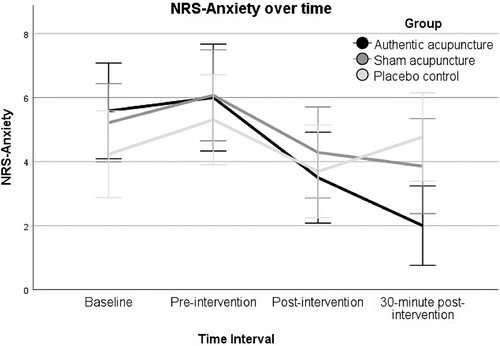
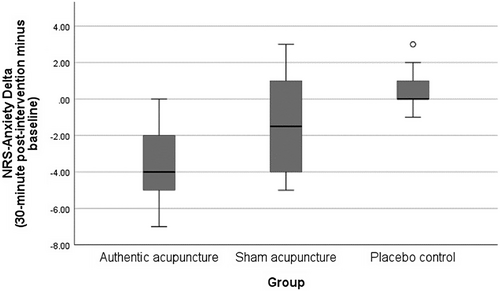
To evaluate significance of change in anxiety, we calculated a two-way repeated-measures ANOVA, which showed a statistically significant group difference (F(2,36) = 8.0, p = .001; η2 = 0.31), a group × time interaction (F(6,108) = 5.1, p = .011, η2 = 0.22), and a time difference (F(3,108) = 21.3, p = .001, η2 = 0.37) in self-reported NRS-Anxiety from baseline to 30-min post intervention among the three study groups.
To evaluate the significant differences across the three groups, we conducted pairwise comparison using Scheffe test, which revealed that the authentic intervention group was significantly less anxious compared with both the sham (mean difference ± s.e. = −2.2 ± 0.81, p = .033) and placebo (−4.12 ± 0.83, p = .001) control groups. There was no significant difference in anxiety between the sham and control groups (p = .071).
3.3 User feedback on usability and acceptability of the acuhealth device
In terms of the comfort of the acupuncture device, most participants (77%, n = 30) reported a high comfort level, 18% (n = 7) reported a medium comfort level and 5% (n = 2) reported a low comfort level.
In order to evaluate any potential sensations produced by the device, we evaluated evidence-based acupuncture stimulation effects based upon De-qi, a composite of unique sensations that has been a subject of debate regarding its role in indicating acupuncture's effectiveness.25, 26 Table 2 presents the sensations perceived by group. Chi-square analysis showed no significant differences in correlations between sensations perceived and group assignment.
| Authentic intervention group (n = 12) | Sham intervention group (n = 14) | Control group (n = 13) | Correlation with group assignment (Chi-squared test) | Correlation with delta anxiety level (30 min post-intervention and baseline) | |
|---|---|---|---|---|---|
| Heat sensation on ears, felt some level of heat/no heat at all | 5 (42%)/7 (58%) | 3 (21%)/11 (79%) | 5 (38%)/8 (62%) | χ2 (2, 39) = 6.4, p = 0.385 | rs (37) = −0.4, p (2-tailed) = 0.018 |
| Other sensation on ears, felt some level of other sensation/no other sensation at all | 7 (58%)/5 (42%) | 6 (43%)/8 (57%) | 3 (23%)/10 (77%) | χ2 (2, 39) = 5.0, p = 0.08 | rs (37) = −0.4, p (2-tailed) = 0.028 |
Spearman's rank-order correlations included data from all treatment groups combined. These correlations showed a medium, statistically significant correlation between NRS-Anxiety reduction (from baseline to 30 min post-intervention) and both heat sensation (rs(37) = −0.40, p = .018) and other sensations (rs(37) = −0.40, p = .028). These results suggested anxiety relief (negative of 30-min post-intervention minus baseline anxiety level) moderately and positively correlated with the feeling of heat and other sensations throughout the process.
4 DISCUSSION
Auricular acupuncture has been found to have clinically significant impacts on situational anxiety in several contexts.6, 27-29 Under the conditions of this proof-of-concept feasibility study, results showed that auricular laser acupuncture implemented with the AcuHealth V1.0 system demonstrated efficacy in reducing parental anxiety during children's surgery and there were no adverse effects of the device. Previous research by our group9 demonstrated that auricular acupuncture delivered by press needles significantly decreased preoperative parental anxiety and the present study demonstrates feasibility of delivering this intervention via lasers, which may be a more amenable approach for needle-averse populations, including children.
Our study also explored the usability and acceptability of the AcuHealth V1.0 device and demonstrated that the device was well-tolerated. The use of cameras with the potential to program the device to automatically detect acupoints supports the potential future implementation of the AcuHealth device by non-TCM trained practitioners, including Anesthesiologists.
The relationship between De-Qi sensations and the therapeutic efficacy of acupuncture remains controversial.30 “De-Qi” refers to a set of sensations commonly experienced during acupuncture, such as heaviness, numbness, warmth, or a tingling sensation, which are traditionally believed to indicate effective needle placement and stimulation of acupoints. The medium correlation observed in our study was specifically between parent self-reported anxiety and the sensations they experienced. There was a lack of significant differences in sensation experiences among groups. In other words, while individual sensations such as heat were correlated with changes in anxiety levels, the group assignment (whether authentic acupuncture, sham, or placebo) did not correlate with these sensations. This aligns with previous findings that suggest subjective sensations experienced during acupuncture do not necessarily correlate with the therapeutic efficacy of the treatment. Our data support this as the therapeutic outcomes (as measured by anxiety reduction) were more closely tied to the intervention group (authentic, sham, placebo) rather than the subjective sensations themselves. these findings also underscore the complexity of acupuncture's mechanisms and the subjective nature of De-Qi, affected by factors such as emotion and cognition which can vary widely without directly influencing clinical outcomes. The observed discrepancy underscores the complexity of correlating subjective sensations with objective clinical effectiveness, and it highlights the need for careful interpretation of how subjective experiences are integrated into therapeutic outcomes. This insight is crucial for further research and application of the device, ensuring that efficacy is not solely judged by patient perception alone.
Findings from this study support the possibility of incorporating laser wearable techniques into the treatment of preoperative anxiety and provide additional possibility for clinical application given the role of acupuncture in pain relief.2, 31-33 Although we are unable to extrapolate anxiolysis and comfort finding to other populations or assume the treatment anxiolysis results would be the same on another time point, findings from this study set the stage for acceptability of this approach to relieve preoperative anxiety in an efficient manner that is well-received.
In contrast to pharmaceutical interventions, acupuncture therapy with the traditional needle, needle with electrodes, or even optical laser, is generally believed to work by activating small, myelinated nerve fibers that send impulses into the spinal cord, etc., causing a measurable release of endorphins into the blood.34 With adjustable laser power and wavelength in the AcuHealth system, this project also sets a foundation for future efforts to validate the laser acupuncture mechanism on anxiolytic and pain-relief effects while optimizing its therapeutic protocol.
Subsequent research should focus on larger samples, diverse surgical settings, and extended postoperative periods to validate and expand on these findings. Future efforts can also aim to assess the effectiveness of laser acupuncture by employing quantifiable biomarkers that can establish a direct correlation to the treatment effectiveness.
To conclude, our study demonstrated that auricular laser acupuncture, administered via the AcuHealth V1.0 at known anxiolytic acupoints, decreased parental anxiety after 30 min in parents who received treatment immediately after their children were taken to the operating room with no adverse effect.
ACKNOWLEDGMENTS
The authors would like to express their gratitude to the Henry Samueli Foundation for its financial support of this study. Special thanks are extended to Dr. John Ives, Ms. Joan Walter, and Dr. Ruth McCarty for their invaluable discussions and insights into the acupuncture research.
FUNDING INFORMATION
This work was supported by the Samueli Institute.
CONFLICT OF INTEREST STATEMENT
The authors declare no competing interests.
ETHICS STATEMENT
This study was conducted in accordance with the Declaration of Helsinki, and the protocol was approved by the Ethics Committee of the Children's Hospital of Orange County (CHOC) Institutional Review Board.
CONSENT
Informed consent was obtained from all individual participants included in the study.
CLINICAL TRIAL REGISTRATION
This study is registered with Children's Hospital of Orange County (CHOC) Institutional Review Board, registration number 220111.
Open Research
DATA AVAILABILITY STATEMENT
All data generated or analyzed during this study are included in this published.



